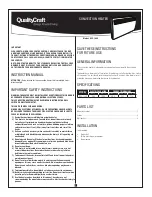
PAGE 10
Q-SERIES DI HEATER OPERATION / MAINTENANCE MANUAL
3
INSTALLATION
3.1 UNPACKING
Remove heater system from crate and inspect heater cabinet for any
signs of damage (dented panels, paint scratches, etc.). Shock indicators
on the heater cabinet should be checked for rough handling during
shipment. Any damage to the system should be reported to the carrier
immediately.
CAUTION:
Heavy Object. When lifting or moving the system,
follow safe heavy object handling methods to prevent injury.
Be careful to not damage the fittings located on back of heater cabinet
when using a dolly or forklift.
3.2 LOCATION
Locate the heater near the point-of-use to reduce plumbing heat loss.
Access to the
side access panels will be necessary for maintenance and
utilities hook-up.
3.3 UTILITY HOOK-UP
All utility hook-ups associated with the DI water heater are easily
accessible and are referenced in the Appendix.
After positioning heater at operating location, adjust the four leveling feet
until the heater is level and stable.
Connect the cold DI supply line to the “Cold DI Inlet” connection.
Connect the hot DI process lines to the “Hot DI Outlet” connection.
Use only hot DI compatible plumbing components. They must be
rated at a minimum of 110°C (230°F) and 414kPa (60 psig).
NOTE:
It is recommended that the hot water supply line have a bleed, or
purge, at the point-of-use to reduce the possibility of stagnating the DI
water in the heaters when not in use. The amount of this bleed is best
evaluated on a case-by-
case basis, taking into account each user’s
criteria and production standards.
Recommendation: Either insulate the hot DI water process line or
place a Hot Surface hazard warning (shown below) on the tubing
every 20 feet. Conform to local codes while evaluating hot water line
routing.











































